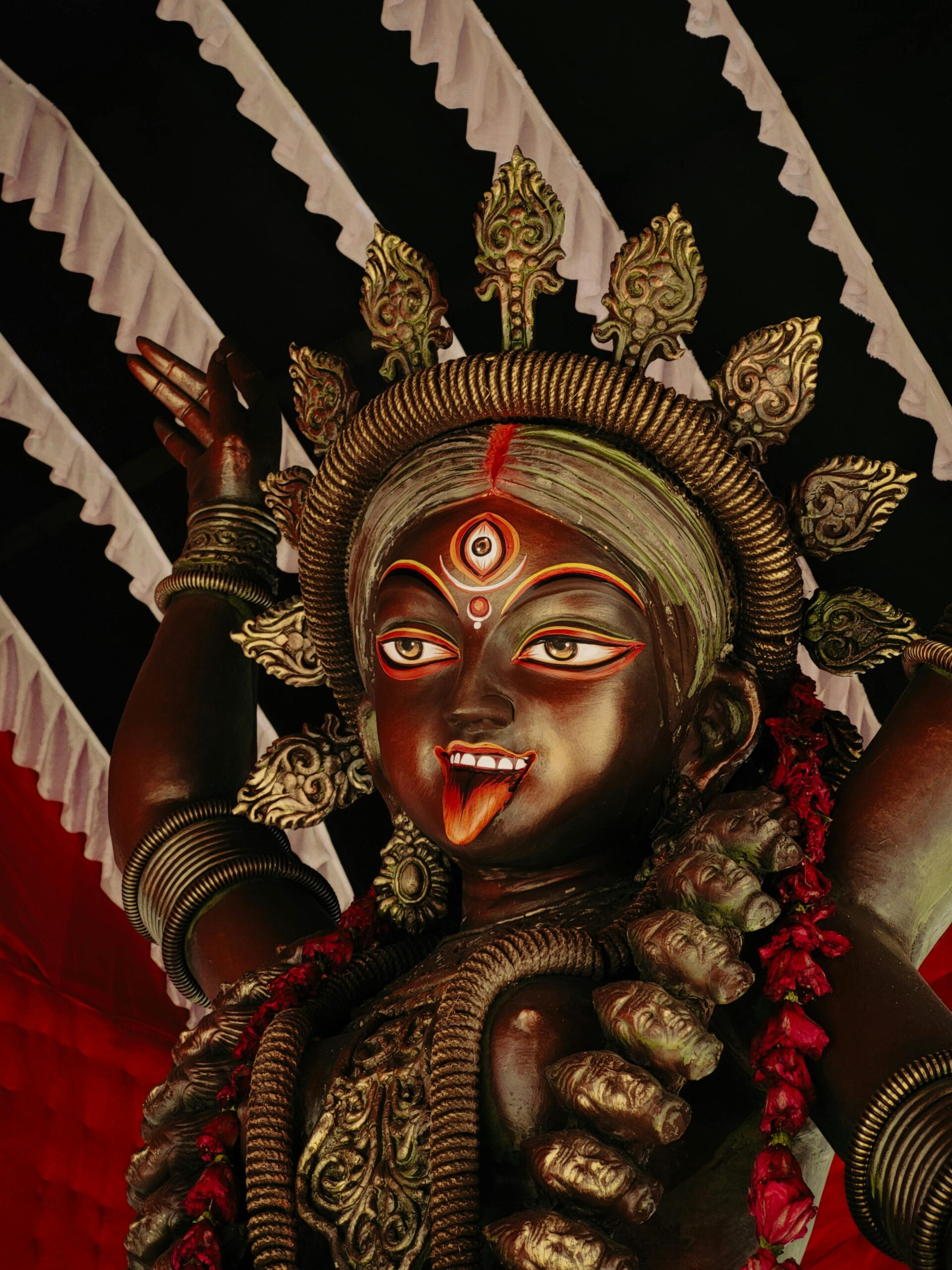
Culture Wrappings IV: Closeted Puja
As someone who will probably not be a homeowner in this lifetime, at random moments in the day it dawns on me: I grew up in a house that has two walk-in closets. One was in my parents’ room and the other served as the quasi study/playroom for my sister and I and the changes in the computers on the desk were a kind of timeline all their own.
The walk-in closet in this room became our mandir, our space for praying at home with an altar on one wall and enough space for the four of us to fit side by side while sitting cross-legged. At least in my experience, Hindus within diaspora communities don’t typically have an equivalent of going to church on Sundays. At least in my experience, if someone was going to a big ‘public’ mandir the reason was related to either illness or matrimony. Hinduism is chiefly practiced within the home spaces by yourself, with immediate family, or in ‘small groups’ – small groups being a term which for Indians means about…forty people? Maybe fifty?
The home mandir is integral to daily living. It’s your ‘last stop’ before you start your day and before you go to bed. If something good happens, you go here to show your gratitude. When something challenging or terrible happens, you come here for comfort and strength.
When our parents first started leaving us alone at home, my mom’s instructions were to take the phone (back when cordless house phones were still a thing) and go straight to the mandir if anyone tried to break in. Child me had visions of a transparent, Star Trek style force field that would keep perpetrators from crossing the threshold. When I got older I agonized over the thought that whatever protection given to me might be voided by the fact that I would also bring the fireplace poker with me and – in this flawless scenario – not be afraid to use it.
The necessity of the mandir is on the same level as having dedicated kitchen and sleeping spaces. But its presence is also something of a running joke since the mandir usually occupies secondary spaces i.e. in a closet, in a cabinet, on a shelf, or in a corner behind a door. I’ve been to a lot of pujas at people’s homes where everyone had to squeeze into a narrow hall, knees touching our neighbors’ as we gazed up at the highest shelf in the towel closet.
This is what I know of the home mandir, which could go a long way in explaining why it feels so uncomfortable to compare these humble but much loved spaces with their five-star luxury counterparts in the pages of Architectural Digest India. In the hope of finding people who had posted pictures of their coat closets and plastic storage drawers draped with saffron cloth, I discovered that puja rooms are apparently also, a vibe.
Of course, like anything in your home or in the life you present to the outside world, the one who has the biggest / best / most beautiful /tasteful / expensive whatever it is, is winning. And if you have the money to make something over in a way that pleases you, you’ll probably do it.
Religion isn’t exempt from this. Maybe you want to add a bit of antique flair to your mandir. In that case, think about offsetting your black and white tiled floors with a vintage glass cabinet to house an enormous, yet tasteful statue of Krishna playing the flute. Because as we all know, the gods are suckers for art deco flooring and the distressed wood aesthetic.
Or, you might be one of those regular people with a waterbody in your home. In that case, the magazine recommends putting up a brick divider wall with enough spaces in between to allow natural sunlight to flow through. Strew decorative fake lotus flowers over the water of what was once a swimming pool and you’ve got your humble prayer space, separated from the chaos of the household.
There’s nothing inherently wrong with wanting to make a beautiful space of worship. People visit churches and temples of all religions around the world, drawn in by the beauty of the architecture or the items within. In that sense, I don’t want to mock people for trying to find inspiration from such articles. But when such a high value is placed on sharing aesthetics with the set design for an upscale furniture store, then I feel less guilty for poking fun at you. Instead of treating the mandir as just another part of the interior design universe, the practicality of building sacred spaces in closets or cabinets is the ability to close off this space when necessary.
One reason is meat. Apart from beef and pork, I grew up eating meat (minus some days of the week when we were strictly vegetarian). Cooking anything with meat meant first making sure the door to the puja room was shut to keep the smells from drifting inside. Like the good California folk we are, we were also regular barbecuers and grillers. So enthusiastic were we about cooking our food over fire that we sometimes forgot this crucial step until half of a chicken hit the grill. Then, my sister or I would sprint upstairs, two at a time, to reach the door before the aromas of meat smoke could curl their way through the open windows.
In case you were wondering, the Hindu dietary universe does not just revolve around turmeric, Ayurveda, and cows being sacred. Technically, Hindus are supposed to be total vegetarians, but through history, migration, capitalism, class values, etc. that has long since morphed into a personal or family choice. When I first decided to go vegetarian I got repeated lectures about how this equated to me not enjoying life because of course, coming from a family that could afford to regularly consume meat was a point of pride.
Another reason for closing the mandir door was for non-Hindu visitors. Again, nobody specifically instructed me to conceal this room from non-Hindus. It was just a thing we did so that it was normal to the point where I became very protective of keeping this space private. Like many things in an Indian household, nobody wastes time with explanations. Sometimes you just have to do things and are expected to understand why via some kind of mental osmosis.
Maybe this was a courtesy to guests since you never knew who might be offended or upset by this. Or, perhaps this was to keep out the curious who might want to closely examine things as if we lived in a reenactment house. Even someone who expresses genuine curiosity has a way of making you feel like a museum exhibition. When it came to our cultural heritage, behaviours, foods, and certain actions were expressed outwardly. Being a Hindu on the other hand was something for the family sphere only.
The fallen ash from the incense is what you would use during a puja to make a tikka mark to take blessings. We only did this on the weekends because we slept a bit later and had long breakfasts as a family. By the time we would be ready to leave the house, the ash would have faded. One seventh grade morning, I decided to adorn my forehead with a particularly fat thumbprint of ash. When I came downstairs for breakfast, my mother pointed this out to my father, bewildered by my ridiculous decision, before rubbing the tikka from my forehead.
Around this time, I also went through a phase of wearing a necklace of the goddess Kali which I had bought at a pagan store – a fact which would have horrified my mother had she known at the time. The necklace is a simple black cord with a Kali pendant a little bit larger than my thumb. Kali is as she is often depicted, with a sickle in one of her multiple hands and the head of a freshly decapitated demon in the other. Her husband, Shiva, has thrown himself under her feet to stop her thunderous dance which is powerful enough to destroy the world.
Suffice to say, as a piece of jewelry on an otherwise meek pre-teen girl, it is a bit full on compared to wearing other religious symbols. So of course, this invited a lot of perfectly natural curiosity. This is also around the time when I learned to become more guarded about being Hindu and thinking back, it’s because people were fascinated by Kali’s image. But I don’t think anyone asked what it was actually about. What was happening, what did this goddess represent? I have a strong memory during this time of watching with gritted teeth as someone examined the pendant between two fingers, one dotted with a large, sticky booger, the thumb with its dirty nail in danger of pressing into the sickle as they giggled at her fierce expression.
Although my parents found it weird, they never actually forbade me from wearing the necklace. I stopped wearing it shortly after the booger-finger incident. Of course that person didn’t mean any disrespect. It was more that the kind of interest I was inviting not only failed to share any real knowledge, it also clashed with wanting to treat my physical items with any degree of sacredness. Especially as I didn’t have the heart to tell someone they couldn’t touch the necklace.
Having seen Kali’s image being co opted for use as a feminist symbol has only reinforced the desire to keep this part of myself private. I do have a long-fostered hypersensitivity to two kinds of curious people: someone who wears tikkas at Burning Man or the self-appointed religious studies expert who knows things because they listen to podcasts and is against organized religion.
Whatever you believe or don’t believe, we’re all just riding our respective waves, so I’ll share what I’m trying to make into my standard response anytime someone asks me to ‘explain Hinduism.’
Apart from some dietary restrictions, the only ‘rules’ I am really bound to are pretty much standard in any religion. Strive to be a good person to yourself and others and when you screw up acknowledge your mistakes and grow from that. Karma (basic: your actions in the present affect your future) and Dharma (basic: duty, purpose in life) kind of run in the background of everything you do, but neither of them are supposed to chokehold you into being a good person out of fear. Also, nowhere is it written that queerness or not identifying in the gender binary are wrong or sinful things.
Years later, I still don’t have enough closet space to put in a mandir. Instead, I have a simple wooden box that I painted when I was seventeen and filled with some of the pictures and statues that I had collected over the years. That box is nestled among my books, some of the things which I cherish the most. I can look at nights of praying with my enormous family, moments of pure being lost in the beautiful music and stories, without feeling unmoored any longer. I feel more deeply connected to my religion than ever even if that is only within myself.
Everything I’ve wanted to write and had to leave out when it comes to talking about faith and religion seems, to my eyes, naive and over-simplified. On the other hand, maybe it can’t hurt to inject some of that innocence into your personal relationship with your beliefs. Personally, I want to believe that adopting a kind of quiet faith policy means that more people of different backgrounds might go a long way towards fostering mutual understanding.

